Foxtail (Raceme)
Dogs
Foxtail (Raceme)
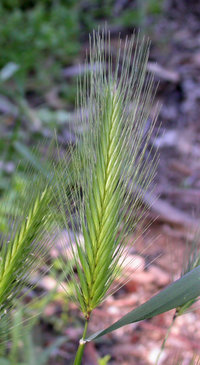 Hordeum murinum, a common source of foxtails in many areas
Hordeum murinum, a common source of foxtails in many areasFoxtails
are spikelets
or spikelet clusters of
grasses (some of
which are themselves called foxtails) that can become a health hazard for
long-haired dogs and
other domestic animals, and a nuisance for people. Foxtails are also called "speargrass".
Source
The name "foxtail" is applied to a number of grasses that have bushy
spikes of
spikelets that resemble the tail of a
fox. Not all of these
are hazardous; most of the hazardous ones, in the genus
Hordeum,
are also called "wild barley".
Other grasses also produce hazardous spikelets. The spikelets are sometimes
called foxtails, even though the grasses are not.
Structure
All foxtails have a hardened tip, sometimes called a "callus", and
retrorse barbs, pointing away from the tip of the callus. Wild barleys have
clusters of three spikelets, and the callus is the portion of the
rachis to which
they attach. In other grasses, such as
needlegrass and
brome grasses,
the foxtail consists of a single spikelet, with the callus being the hardened
lemma tip. Retrorse barbs can be found on the callus, the lemmas, and the awns.
Mode of Action
The spikelets or spikelet clusters of foxtails are adapted for animal
dispersal: The foxtails disarticulate easily, the barbs cause the foxtail to
cling to fur, and movement of the animal causes the foxtail to burrow into the
fur, since the barbs permit it to move only in the direction of the callus. In
wild mammals
that inhabit the native ranges of foxtail grasses, the fur is ordinarily short
enough that the foxtails will eventually become dislodged, dispersing the seed.
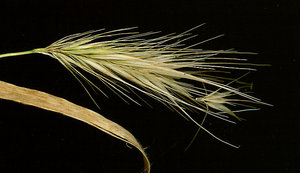 The spike of Hordeum murinum disarticulates into clusters of three
spikelets
The spike of Hordeum murinum disarticulates into clusters of three
spikelets
Especially in the long-haired dogs and other domestic animals, the foxtails
can become irreversibly lodged. Foxtails can also enter the
nostrils and
ear canals
of many mammals. In all these cases, the foxtail can physically enter the body.
Muscular movements (or air flow, in the case of nostrils) can cause the
foxtails to continue to burrow through
soft
tissues and
organs, causing
infection
and physical disruption, which in some cases can result in death.
Foxtails can also work through clothing, particularly fabric shoes and socks,
causing discomfort to people while walking.
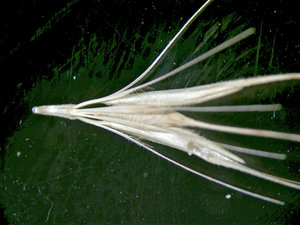 Each spikelet cluster is held together by a portion of the rachis
Each spikelet cluster is held together by a portion of the rachis
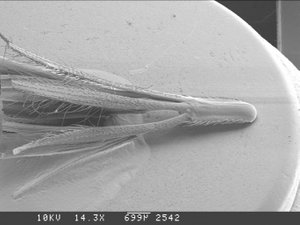 Spikelet cluster viewed by scanning electron microscope
Spikelet cluster viewed by scanning electron microscope
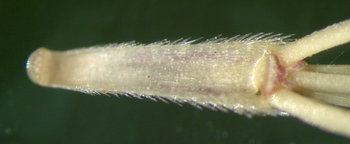 The rachis segment, sometimes called a "callus", is hardened, and covered with
retrorse barbs
The rachis segment, sometimes called a "callus", is hardened, and covered with
retrorse barbs
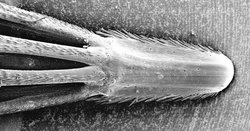 Rachis segment viewed by scanning electron microscope. Note the retrorse barbs
on both the rachis and the pedicels.
Rachis segment viewed by scanning electron microscope. Note the retrorse barbs
on both the rachis and the pedicels.
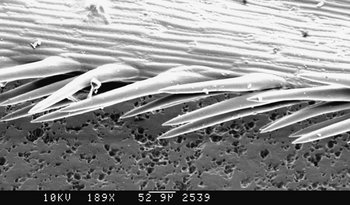 Retrose barbs on lemma.
Retrose barbs on lemma.
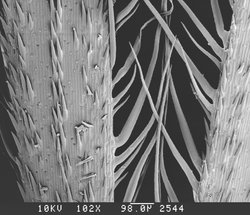 Retrorse barbs and trichomes on lemma.
Retrorse barbs and trichomes on lemma.
Prevention
Control
Many wild barley species are
weeds of disturbed
habitats, and their growth is encouraged by foot traffic of humans and domestic
animals. Control consists of restricting traffic to established paths, and
eradication of wild barley by mechanical removal or
herbicide.
Some other foxtail-producing grasses, especially needlegrasses, are dominant
species in stable
grassland
habitats. Control attempts in these cases can actually be conterproductive,
creating disturbed habitats where wild barleys may thrive.
Avoidance
Foxtails are a problem beginning when the grass
inflorescences begin to disarticulate, and ending when the spikelets or
spikelet clusters are mechanically abraded or incorporated into the
soil,
turf, or
leaf
litter. In some habitats, this can be a matter of weeks, but in others it
may require months, especially if different species flower and fruit at
different times during the season. Nevertheless, restricting dogs at these times
from areas known to have foxtails is very effective.
Removal
Combing of fur removes foxtails along with
burrs and other
detritus, but potentially the most dangerous foxtails are found in areas easily
missed: the axillae,
between the toes, and in nostrils and ear canals. The first two should be
routinely examined in long-haired dogs. In the latter two cases, dogs may
exhibit symptomatic behavior, such as
sneezing or
pawing.
Treatment
Foxtails that have progressed no further than surface
lesions are
ordinarily removed and the lesion treated with
antiseptic
and bandaged
if necessary. Once a foxtail has passed beneath the skin, dogs are often treated
with systemic
antibiotics,
and the foxtail either allowed to encyst and degrade, or in the case of actual
or imminent organ damage, removed surgically (surgical removal can be
problematic, since foxtails cannot easily be imaged by
x-ray or
ultrasound).
Foxtails imbedded in the nostrils can migrate into the nasal
turbinates,
causing intense distress, and in rare cases into the brain. Foxtails in the ear
canal can puncture the eardrum and enter the middle
ear, causing hearing
loss. In both cases, detection and early removal is the best treatment.
Folklore
Because foxtails "burrow" through fur, soft tissues, and organs, some people
think of them as parasites. Although they may be technically "alive", containing
viable grass seeds, foxtails are equally dangerous dead, since their burrowing
is purely mechanical, in response to movements of the affected animal.
External links
Home | Up | Fibrosarcoma | Flea | Foxtail (Raceme)
Dogs, made by MultiMedia | Free content and software
This guide is licensed under the GNU
Free Documentation License. It uses material from the Wikipedia.
|




